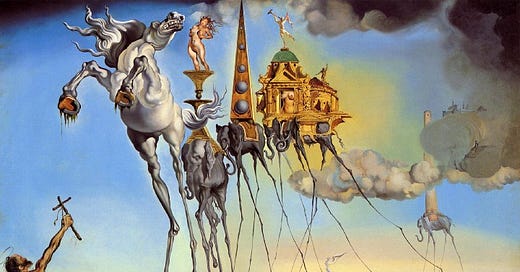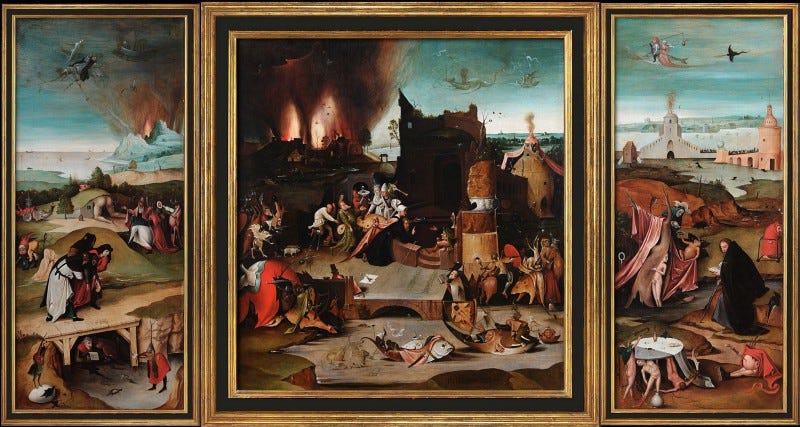Did You Know About the Bible Connection of Dali’s Elephants?
Edition #44 - When Dali lost to Max Ernst
Hi friend,
Thank you for being a valuable subscriber to my newsletter Pursuit. If you think this newsletter could be helpful to art [readers, thinkers, writers, students, and interpreters], please share the link.
Did You Know About the Bible Connection of Dali’s Elephants?
What if I tell that the elephants in Dali’s The Temptation of St Anthony are in stark contrast with the biblical interpretation of “numbers?”
The number “one” in the bible represents unity. Dali’s first elephant symbolizes the opposite of that. A woman holding her breasts apart.
In the bible, the number “two” represents division. Dali’s second elephant, on the other hand, symbolizes an obelisk that holds together 5 spheres.
The number “three” represents completeness. Dali’s elephant has only two legs.
“Four” symbolizes God’s own creation — the earth. In contrast, Dali’s fourth elephant depicts man-made structures.
The number “five” in the bible stands for God’s grace. Dali decided to depict his fifth elephant with dark clouds surrounding a phallic-looking building.
Dreams fascinated Dali.
He once said, “Give me two hours a day of activity, and I’ll take the other twenty-two in dreams.”
The Temptation of St Anthony is Dali’s signature art piece that intertwined biblical narrative and his idiosyncratic interpretation of the temptations endured by the Christian monk Saint Anthony.
600 years ago, when Hieronymus Bosch delved deep into the abyss of his mind and came up with the most unusual interpretations of hell, demonology, and folly of men in The Temptation of St Anthony, Dali reflected this theme through death and desire.
Saint Anthony was a Christian monk born in 251 AD. After the death of his parents, he shunned all his material possessions and lived a life of solitude in the Libyan desert.
The Saint conquered demonic assaults and sexual temptations to attain transcendence.
Bosch gave expression to the spiritual unrest of his time, making powerful allusions.
Let’s zoom in on the left panel —
In the sky, there is a cohort of demons persecuting Anthony.
Saint Grotto is carved within a hill in the shape of a man, whose backside forms the entrance.
In the foreground, a monk and a man support Anthony. The man seems to be Bosch.
Under the bridge, the clergy read the indulgences with a red seal.
What does it all signify?
In the medieval era, “indulgences” became common in the Church. Paying silver or gold to buy purgation from the Church was like a contract between the Church and men to reduce the severity of their punishments and pave their path to heaven. Soon these “purchases of Indulgences” got corrupted and the wealthy people started bribing bishops and priests. This was one of the significant triggers for the Protestant Reformation.
Now onto the Center panel —
The evil priests and demons conduct an elaborate perversion of the Catholic Mass.
A serpentine-tailed nun offers something to another nun.
A toad mocks the shape of the Eucharist.
An owl sits on the head of the man having a lute player and another man with a hurdy-gurdy. These musical instruments were sinful.
The right panel depicts the contemplation of St. Anthony.
A naked woman tries to seduce him. Another woman tries to pour wine into a glass of a demon, but Anthony sits in a quiet corner.
Coming back to Dali’s version, he painted this piece while he was in New York and took part in a contest. Apparently, the winning picture was to be used in the film The Private Affairs of Bel Ami.
Well, Dali lost to Max Ernst’s version of the temptation.
Dali’s The Temptation of St. Anthony is in the Royal Museum of Fine Arts of Belgium, Brussels, and is 90 cm by 119.5 cm.
In the foreground, St. Anthony kneels, holding the crucifix. He points it toward a rearing horse, a series of elephants, and a naked lady standing on a golden chalice. This symbolizes his endurance towards his temptations and carnal desires. His faith in God will help him reach the stage of salvation. His other hand rests on a rock.
A halo around Anthony’s head depicts a Christ-like aura.
Notice the skull near his right leg, a symbol of death and mortality; a recurring theme in Dali’s oeuvre.
The nude woman precariously balances herself on the golden chalice. Holding her buxom tightly, she seems in distress and moves away, particularly by the rearing horse.
The golden chalice rests on the back of an elongated elephant. This motif made me think of the painting Frenzy of Exultations by Władysław Podkowiński. In Dali’s version, the horse shocks the woman, whereas Podkowiński’s horse seduces her.
Next in line are a series of 4 elephants, carrying buildings on their back.
The second one carries an obelisk inspired by Bernini’s elephant. The third and fourth carry Venetian edifices in the style of Palladio.
In the background, the last elephant carries a tall tower with phallic overtones. The heavy dark clouds fill the sky; but one can view a few fragments of the Escorial, a symbol of spiritual order.
But hold on. What is the significance of these elephants in this artwork?
There are 5 elephants in this painting. All of them have long, multi-jointed, almost invisible, disproportionate legs.
The elephants in Dali’s paintings reflect domination, power, and masculinity. In fact, these elephants contribute to the concept of “contrast and harmony” because in reality elephants can’t stand balancing on these thin gangly legs.
Elephants depict strength. They carry heavy objects like obelisks.
Wait, before you go, did you notice the man and the woman walking toward each other?
The woman holds a cross. It is perhaps the key they might rescue the man in this arid desert. Who knows?
Here’s the latest video on our YouTube channel—








